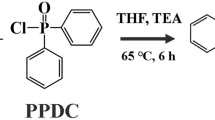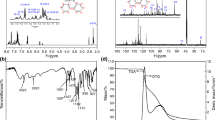Abstract
The integration of high mechanical toughness, impact strength as well as excellent flame-retardant properties toward epoxy resins (EPs) have always been a dilemma. The inadequate overall performance of EPs severely restricts their sustainable utilization in engineering aspects over long-term. Herein, a new bio-based agent (diglycidyl ether of magnolol phosphine oxide, referred as DGEMP) derived from magnolol (classified as lignan), extracted from natural plants Magnolia officinalis, was successfully synthesized and further employed as a flame-retardant reactive additive to diglycidyl ether of bisphenol A (DGEBA). As demonstration, the composite resin, DGEBA/15DGEMP (15 wt% DGEMP), achieved an Underwriters Laboratories-94 V-0 rating with a high limiting oxygen index (LOI) value (41.5%). In cone calorimeter tests, it showed that heat release and smoke production were effectively inhibited during combustion, wherein the peak heat release rate (PHRR) value of DGEBA/15DGEMP was reduced by 50% compared to neat DGEBA. Additionally, it exhibited a superior tensile strength (82.8 MPa), toughness (5.11 MJ/m3) and impact strength (36.5 kJ/m2), much higher than that of neat DGEBA (49.7 MPa, 2.05 MJ/m3 and 20.9 kJ/m2). Thus, it is highly anticipated that DGEMP imparts significantly improved mechanical and fire-retarded properties to conventional EPs, which holds a great potential to address the pressing challenges in EP thermosets industry.
Similar content being viewed by others
References
Jin, F. L.; Li, X.; Park, S. J. Synthesis and application of epoxy resins: A review. J. Ind. Eng. Chem. 2015, 29, 1–11.
May, C. Epoxy resins: chemistry and technology. Routledge: 2018.
Gao, T. Y.; Wang, F. D.; Xu, Y.; Wei, C. X.; Zhu, S. E.; Yang, W.; Lu, H. D. Luteolin-based epoxy resin with exceptional heat resistance, mechanical and flame retardant properties. Chem. Eng. J. 2022, 428, 131173.
Kong, Q.; Zhu, H.; Huang, S.; Wu, T.; Zhu, F.; Zhang, Y.; Wang, Y.; Zhang, J. Influence of multiply modified FeCu-montmorillonite on fire safety and mechanical performances of epoxy resin nanocomposites. Thermochim. Acta 2022, 707, 179112.
Auvergne, R.; Caillol, S.; David, G.; Boutevin, B.; Pascault, J. P. Biobased thermosetting epoxy: present and future. Chem. Rev. 2014, 114, 1082–1115.
Mi, X.; Liang, N.; Xu, H.; Wu, J.; Jiang, Y.; Nie, B.; Zhang, D. Toughness and its mechanisms in epoxy resins. Prog. Mater. Sci. 2022, 130, 100977.
Ye, G.; Huo, S.; Wang, C.; Shi, Q.; Yu, L.; Liu, Z.; Fang, Z.; Wang, H. A novel hyperbranched phosphorus-boron polymer for transparent, flame-retardant, smoke-suppressive, robust yet tough epoxy resins. Compos. Part B: Eng. 2021, 227, 109395.
Wang, X.; Zhou, S.; Guo, W. W.; Wang, P. L.; Xing, W.; Song, L.; Hu, Y. Renewable cardanol-based phosphate as a flame retardant toughening agent for epoxy resins. ACS Sustain. Chem. Eng. 2017, 5, 3409–3416.
Huo, S.; Song, P.; Yu, B.; Ran, S.; Chevali, V. S.; Liu, L.; Fang, Z.; Wang, H. Phosphorus-containing flame retardant epoxy thermosets: recent advances and future perspectives. Prog. Polym. Sci. 2021, 114, 101366.
Mendis, G. P.; Weiss, S. G.; Korey, M.; Boardman, C. R.; Dietenberger, M.; Youngblood, J. P.; Howarter, J. A. Phosphorylated lignin as a halogen-free flame retardant additive for epoxy composites. Green Mater. 2016, 4, 150–159.
Velencoso, M. M.; Battig, A.; Markwart, J. C.; Schartel, B.; Wurm, F. R. Molecular firefighting—how modern phosphorus chemistry can help solve the challenge of flame retardancy. Angew. Chem. Int. Ed. 2018, 57, 10450–10467.
Huo, S.; Zhou, Z.; Jiang, J.; Sai, T.; Ran, S.; Fang, Z.; Song, P.; Wang, H. Flame-retardant, transparent, mechanically-strong and tough epoxy resin enabled by high-efficiency multifunctional boron-based polyphosphonamide. Chem. Eng. J. 2022, 427, 131578.
Xue, T.; Fan, W.; Zhang, X.; Zhao, X.; Yang, F.; Liu, T. Layered double hydroxide/graphene oxide synergistically enhanced polyimide aerogels for thermal insulation and fire-retardancy. Compos. Part B: Eng. 2021, 219, 108963.
Chu, F.; Qiu, S.; Zhou, Y.; Zhou, X.; Cai, W.; Zhu, Y.; He, L.; Song, L.; Hu, W. Novel glycerol-based polymerized flame retardants with combined phosphorus structures for preparation of high performance unsaturated polyester resin composites. Compos. Part B: Eng. 2022, 233, 109647.
Liu, M.; Peng, B.; Su, G.; Fang, M. Reactive flame retardants: are they safer replacements. Environ. Sci. Technol. 2021, 55, 14477–14479.
Guo, W.; Liang, F.; Chen, S.; Yu, K.; Sun, J.; Pang, Z.; Fei, B. Magnolol-derived thiol-ene photo-polymerized membranes with intrinsic anti-flammability and high transparency. Compos. Part B: Eng. 2022, 242, 110074.
Teng, N.; Yang, S.; Dai, J.; Wang, S.; Zhao, J.; Zhu, J.; Liu, X. Making benzoxazine greener and stronger: renewable resource, microwave irradiation, green solvent, and excellent thermal properties. ACS Sustain. Chem. Eng. 2019, 7, 8715–8723.
Qi, Y.; Weng, Z.; Zhang, K.; Wang, J.; Zhang, S.; Liu, C.; Jian, X. Magnolol-based bio-epoxy resin with acceptable glass transition temperature, processability and flame retardancy. Chem. Eng. J. 2020, 387, 124115.
Cao, Q.; Weng, Z.; Qi, Y.; Li, J.; Liu, W.; Liu, C.; Zhang, S.; Wei, Z.; Chen, Y.; Jian, X. Achieving higher performances without an external curing agent in natural magnolol-based epoxy resin. Chin. Chem. Lett. 2022, 33, 2195–2199.
Yang, H.; Song, L.; Tai, Q.; Wang, X.; Yu, B.; Yuan, Y.; Hu, Y.; Yuen, R. K. Comparative study on the flame retarded efficiency of melamine phosphate, melamine phosphite and melamine hypophosphite on poly(butylene succinate) composites. Polym. degrad. stab. 2014, 105, 248–256.
Braun, U.; Balabanovich, A. I.; Schartel, B.; Knoll, U.; Artner, J.; Ciesielski, M.; Döring, M.; Perez, R.; Sandler, J. K.; Altstädt, V. Influence of the oxidation state of phosphorus on the decomposition and fire behaviour of flame-retarded epoxy resin composites. Polymer 2006, 47, 8495–8508.
Luo, Q.; Liu, M.; Xu, Y.; Ionescu, M.; Petrović, Z. S. Thermosetting allyl resins derived from soybean oil. Macromolecules 2011, 44, 7149–7157.
Jian, R. K.; Ai, Y. F.; Xia, L.; Zhang, Z. P.; Wang, D. Y. Organophosphorus heteroaromatic compound towards mechanically reinforced and low-flammability epoxy resin. Compos. Part B: Eng. 2019, 168, 458–466.
Ma, C.; Li, J. Synthesis of an organophosphorus flame retardant derived from daidzein and its application in epoxy resin. Compos. Part B: Eng. 2019, 178, 107471.
Yu, M.; Zhang, T.; Li, J.; Tan, J.; Zhang, M.; Zhou, Y.; Zhu, X. Facile synthesis of eugenol-based phosphorus/silicon-containing flame retardant and its performance on fire retardancy of epoxy resin. ACS Appl. Polym. Mater. 2022, 4, 1794–1804.
Qi, Y.; Weng, Z.; Kou, Y.; Li, J.; Cao, Q.; Wang, J.; Zhang, S.; Jian, X. Facile synthesis of bio-based tetra-functional epoxy resin and its potential application as high-performance composite resin matrix. Compos. Part B: Eng. 2021, 214, 108749.
Dai, J.; Teng, N.; Liu, J.; Feng, J.; Zhu, J.; Liu, X. Synthesis of bio-based fire-resistant epoxy without addition of flame retardant elements. Compos. Part B: Eng. 2019, 179, 107523.
Liu, X. F.; Xiao, Y. F.; Luo, X.; Liu, B. W.; Guo, D. M.; Chen, L.; Wang, Y. Z. Flame-retardant multifunctional epoxy resin with high performances. Chem. Eng. J. 2022, 427, 132031.
Liu, J.; Dai, J.; Wang, S.; Peng, Y.; Cao, L.; Liu, X. Facile synthesis of bio-based reactive flame retardant from vanillin and guaiacol for epoxy resin. Compos. Part B: Eng. 2020, 190, 107926.
Xu, Y.; Yang, W. J.; Zhou, Q. K.; Gao, T. Y.; Xu, G. M.; Tai, Q. L.; Zhu, S. E.; Lu, H. D.; Yuen, R. K. K.; Yang, W.; Wei, C. X. Highly thermostable resveratrol-based flame retardant for enhancing mechanical and fire safety properties of epoxy resins. Chem. Eng. J. 2022, 450, 138475.
Zhao, D.; Wang, J.; Wang, X. L.; Wang, Y. Z. Highly thermostable and durably flame-retardant unsaturated polyester modified by a novel polymeric flame retardant containing Schiff base and spirocyclic structures. Chem. Eng. J. 2018, 344, 419–430.
Wei, C.; Esposito, D.; Tauer, K. Thermal properties of thermoplastic polymers: influence of polymer structure and procedure of radical polymerization. Polym. Degrad. Stabil. 2016, 131, 157–168.
Ma, X.; Guo, W.; Xu, Z.; Chen, S.; Cheng, J.; Zhang, J.; Miao, M.; Zhang, D. Synthesis of degradable hyperbranched epoxy resins with high tensile, elongation, modulus and low-temperature resistance. Compos. Part B: Eng. 2020, 192, 108005.
Huo, S.; Sai, T.; Ran, S.; Guo, Z.; Fang, Z.; Song, P.; Wang, H. A hyperbranched P/N/B-containing oligomer as multifunctional flame retardant for epoxy resins. Compos. Part B: Eng. 2022, 234, 109701.
Fei, X.; Wei, W.; Tang, Y.; Zhu, Y.; Luo, J.; Chen, M.; Liu, X. Simultaneous enhancements in toughness, tensile strength, and thermal properties of epoxy-anhydride thermosets with a carboxyl-terminated hyperbranched polyester. Eur. Polym. J. 2017, 90, 431–441.
Hu, G.; Zhang, X.; Bu, M.; Lei, C. Toughening and strengthening epoxy resins with a new bi-DOPO biphenyl reactive flame retardant. Eur. Polym. J. 2022, 178, 111488.
Luo, Q.; Sun, Y.; Yu, B.; Li, C.; Song, J.; Tan, D.; Zhao, J. Synthesis of a novel reactive type flame retardant composed of phenophosphazine ring and maleimide for epoxy resin. Polym. Degrad. Stabil. 2019, 165, 137–144.
Jian, R. K.; Ai, Y. F.; Xia, L.; Zhao, L. J.; Zhao, H. B. Single component phosphamide-based intumescent flame retardant with potential reactivity towards low flammability and smoke epoxy resins. J. Hazard. Mater. 2019, 371, 529–539.
Liu, Y.; Liu, B.; Sun, Z.; Zhang, H.; Men, Y.; Hu, W.; Shao, Z. Bioinspired mono-component lignin endowing epoxy resin with simultaneously improving flame retardancy and mechanical properties. Compos. Commun. 2022, 35, 101306.
Li, S.; Zhao, X.; Liu, X.; Yang, X.; Yu, R.; Zhang, Y.; Huang, W.; Deng, K. Cage—ladder-structure, phosphorus-containing polyhedral oligomeric silsesquinoxanes as promising reactive-type flame retardants for epoxy resin. J. Appl. Polym. Sci. 2019, 136, 47607.
Ma, C.; Qian, L.; Li, J. Effect of functional groups of magnolol-based cyclic phosphonate on structure and properties of flame retardant epoxy resin. Polym. Degrad. Stabil. 2021, 190, 109630.
Wang, P.; Yang, F.; Li, L.; Cai, Z. Flame retardancy and mechanical properties of epoxy thermosets modified with a novel DOPO-based oligomer. Polym. Degrad. Stabil. 2016, 129, 156–167.
Yan, H.; Li, N.; Fang, Z.; Wang, H. Application of poly(diphenolic acid-phenyl phosphate)-based layer by layer nanocoating in flame retardant ramie fabrics. J. Appl. Polym. Sci. 2017, 134, 44795.
Li, Y. C.; Mannen, S.; Morgan, A. B.; Chang, S.; Yang, Y. H.; Condon, B.; Grunlan, J. C. Intumescent all-polymer multilayer nanocoating capable of extinguishing flame on fabric. Adv. Mater. 2011, 23, 3926–3931.
Jiang, G.; Xiao, Y.; Qian, Z.; Yang, Y.; Jia, P.; Song, L.; Hu, Y.; Ma, C.; Gui, Z. A novel phosphorus-, nitrogen- and sulfur-containing macromolecule flame retardant for constructing high-performance epoxy resin composites. Chem. Eng. J. 2023, 451, 137823.
Pol, V. G.; Motiei, M.; Gedanken, A.; Calderon-Moreno, J.; Yoshimura, M. Carbon spherules: synthesis, properties and mechanistic elucidation. Carbon 2004, 42, 111–116.
Wu, J. N.; Chen, L.; Fu, T.; Zhao, H. B.; Guo, D. M.; Wang, X. L.; Wang, Y. Z. New application for aromatic Schiff base: high efficient flame-retardant and anti-dripping action for polyesters. Chem. Eng. J. 2018, 336, 622–632.
Chen, H. R.; Meng, W. M.; Wang, R. Y.; Chen, F. L.; Li, T.; Wang, D. D.; Wang, F.; Zhu, S. E.; Wei, C. X.; Lu, H. D.; Yang, W. Engineering highly graphitic carbon quantum dots by catalytic dehydrogenation and carbonization of Ti3C2Tx-MXene wrapped polystyrene spheres. Carbon 2022, 190, 319–328.
Wang, X.; Xing, W.; Feng, X.; Yu, B.; Song, L.; Hu, Y. Functionalization of graphene with grafted polyphosphamide for flame retardant epoxy composites: synthesis, flammability and mechanism. Polym. Chem. 2014, 5, 1145–1154.
Acknowledgments
This work was financially supported by Anhui Provincial Natural Science Foundation for Distinguished Young Scholar (No. 2008085J26), Natural Science Foundation in University of Anhui Province (Nos. KJ2021ZD0119 and 2022AH040251), China Scholarship Council (No. 202008340021), Start-up Fund for Distinguished Scholars in Hefei University (No. 20RC37), Anhui Provincial Natural Science Foundation (No. 2108085QB47) and Research Grants Council of the Hong Kong Special Administrative Region (No. CityU 11208617).
Author information
Authors and Affiliations
Corresponding authors
Ethics declarations
The authors declare no interest conflict.
Electronic Supplementary Information
10118_2023_2932_MOESM1_ESM.pdf
Synthesis of Bio-based Epoxy Containing Phosphine Oxide as a Reactive Additive Toward Highly Toughened and Fire-retarded Epoxy Resins
Rights and permissions
About this article
Cite this article
Wei, C., Gao, T., Xu, Y. et al. Synthesis of Bio-based Epoxy Containing Phosphine Oxide as a Reactive Additive Toward Highly Toughened and Fire-retarded Epoxy Resins. Chin J Polym Sci 41, 1733–1746 (2023). https://doi.org/10.1007/s10118-023-2932-4
Received:
Accepted:
Published:
Issue Date:
DOI: https://doi.org/10.1007/s10118-023-2932-4




